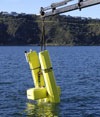
“It is simply the best available collection of essays by climate scientists on the nature of human-induced climate change, the ways scientists have come to understand and measure the risks that it poses, and the options that we face.”
Thus Jeffrey Sachs in his foreword to Climate Change: Picturing the Science edited by Gavin Schmidt and Joshua Wolfe. He has a somewhat proprietary interest in the publication in that much of it is written by scientists associated with his Columbia University’s Earth Institute, but his declaration is not overblown.
Gavin Schmidt is well known to readers of the RealClimate website, of which he was a co-founder. He is a climate scientist at NASA’s Goddard Institute for Space Studies. Joshua Wolfe is a documentary photographer much of whose work focuses on climate change. His is one of three splendid photo essays which punctuate the book, along with many other carefully selected illustrative photographs on almost every page.
Medical terms head the book’s three parts – symptoms, diagnosis and possible cures. Seven climate scientists contribute chapters with one or two experts in technology and policy joining them in part three.
The symptoms section has five headings: the unequivocal warming of the globe; the changes occurring in the Arctic; changes to the chemistry, biology and level of the sea; the likelihood of extreme events; the threat to biodiversity. In all these areas troubles are already apparent or can be seen developing.
The diagnosis section has three chapters. The first describes the drivers of climate and the part played by anthropogenic forcings. The second explains the study of climate “one of the most complex and lively branches in all of Earth science.” Dozens of different fields are involved. The chapter lists some of them: meteorology, oceanography, biology, chemistry, quantum physics, orbital mechanics, and ecology. It has a useful characterisation of the four overlapping groups into which climate scientists can be broadly split: those studying the physical processes in the current climate system, others looking for indications of how and why climates were different in the past, yet others documenting the impacts of change today, and some bringing all these elements together to try and say something about the future. The third chapter discusses prognoses for that future, making a helpful distinction between forecasts, predictions and projections before examining prospects for rising temperatures, rainfall changes, rising sea levels, ocean changes, greenhouse gas feedbacks, decreasing biodiversity, human health risks, and agricultural impacts. Surprises are inevitable, and they are not likely to be benign.
These two sections of the book are straightforward explanations of where the science stands today. They acknowledge plenty of uncertainties. Schmidt states that the book has eschewed polemics “in favour of a ‘warts and all’ exposition of what we know, what we don’t know, and what is already being seen.” The tone is restrained, the content factual. The complexities of the science are not compromised, but the findings are laid out in terms that any general reader can comprehend. Although the path to understanding what is going on has its complications, and there have been major intellectual feats (and sometimes physical ones as well) along the way as the clues have been put together, the basic picture which has emerged is not hard to grasp.
Turning to possible cures in the book’s third section the various, now familiar technologies are surveyed and the political aspects of emission reduction explored. The difficulties of adequate action and internationally agreed policy are acknowledged, but a degree of somewhat dogged hope also finds expression.
Slightly aside from the main thrust of the book, it’s worth drawing attention to a couple of the brief contributions which interleave the major chapters. Elizabeth Kolbert (whose Field Notes from a Catastrophe was my introduction to the seriousness of climate change) has an illuminating reflection on why it has been hard for journalism to communicate the reality of global warming. Naomi Oreskes writes thoughtfully about the scientific consensus on climate change and why it is under no challenge from contrarian claims.
We need to see climate scientists making the kind of communication to the public this book represents. Straight from the horse’s mouth. I don’t imagine all scientists would relish the task, but certainly those chosen for this publication write clearly and accessibly for the lay person. The reader gets not only a survey of where things stand in the areas each of the writers is engaged with but also an awareness of the scope and range of the scientific activity associated with climate change. I doubt most people are aware of the magnitude of the scientific attention the subject is now receiving.
A full picture is what the book provides, mostly through words but also through the striking images which accompany the text. It will be a very helpful aid to readers who want to see that full picture, either because they don’t have hold of it yet or because they want to fill in gaps in their understanding.
It is a large, handsomely produced volume which will adorn any surface on which it lies while its reader works through it. Not at one sitting, I would suggest, but filling in the picture slowly chapter by chapter.
Like this:
Like Loading...
 I’ve been critical of Gerry Brownlee for his early actions and statements as Minister of Energy  in taking over the Energy portfolio. I still am. However in addressing the annual conference of The Aotearoa Wave and Tidal Energy Association (Awatea), held in Wellington this week he produced some encouraging facts and expressions of support which are worth reporting.
I’ve been critical of Gerry Brownlee for his early actions and statements as Minister of Energy  in taking over the Energy portfolio. I still am. However in addressing the annual conference of The Aotearoa Wave and Tidal Energy Association (Awatea), held in Wellington this week he produced some encouraging facts and expressions of support which are worth reporting.
 I realise that I have had several posts on signs of hope from the Obama administration, the last only four days ago, but I can’t forbear offering another one. I have just read the President’s
I realise that I have had several posts on signs of hope from the Obama administration, the last only four days ago, but I can’t forbear offering another one. I have just read the President’s